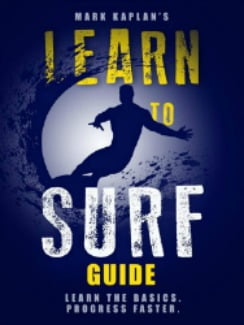How to Surf the Short Board
Shortly after many students start learning to surf they want to know how to surf the short board. In the movies, the surfers are mostly on short boards as they ride big waves or rip in the pockets. It looks so easy.
The short board is an advanced form of surfing, but the long board is often the way many surfers could go to have fun given the amount of time they can spend in the water and their physical conditioning.
Preparing to Surf the Short Board
Surfing is a physical sport and surfing the short board requires the optimum surf specific conditioning. Moving from a high volume soft top surf board 8′ or 9′) to a short board (6″10″ and less) requires a gradual process.
Four things happen as surf boards get shorter. The paddling becomes more difficult. The board becomes less stable catching waves. Riding waves requires new techniques, and the timing of real waves is precise.
Surfers have to master the pop up to ride short boards. I have new students practicing the pop up in their living rooms until they are smooth and land it accurately. Practicing 20 times a day will pay off when trying to catch real waves.
Wave catching has to be precise. The short board wants to be in the spot where the wave arcs over the surfer’s head as it comes under the board. The surfer then paddles three times down the face to catch the wave.
Waves have varying levels of steepness and speed. The bigger the wave, the faster it is traveling and the heavier it is. This means falls are more scary. New short board surfers often start with the corners away from the apex (where the foam first comes over the lip) to catch a slower less steep portion of the wave.
Short board surfers on steep or close out waves, paddle to catch the wave and then point the board toward the pocket before popping up. This saves them from pearling and gets them into the pocket before the wave collapses.
Maneuvers to Surf the Short Board
There are four beginning maneuvers the surfer needs on a short board. The first is a bottom turn to get from surfing down the face to carve into the pocket. The bottom turn is also used to get up the face to escape a collapsing wave. Finally, the bottom turn is used to ride up the face to rip the lip.
Short boards must accelerate in the pocket. This is achieved by using the front foot to push the nose up and down the pocket. Three or four pushes is enough to escape the lip and to begin a trick or maneuver.
The cut back is essential. It is used to reverse direction to return to the power of the wave when the wave starts losing momentum. It is also used to stall while waiting for the power or a barrel. It is also used for style. It is used as the second part of ripping the lip to go back down the face.
All these maneuvers can be found on Youtube. Surfers should watch on video and then watch surfers at the beach. The more you try to execute various scenarios, the more you can learn by observing.
Learn More
For Oceanside Surf Lessons, see the Home Page
See the Post Surf Lessons Begin with Foam Waves
See the Post What You Learn in a 2 Hour Lesson
See the Post How to Progress in Surfing
See My Dry Land and In Water Demo video
See How to Catch a Green/Real Wave video
I have lowered my Course and Book prices for the lock down
My New Surfing Course in an E-Book plus Demo Video
Get the 18 Chapter, 7,500 word Course that can prepare you for a lesson or give you the fundamentals if you are going to try it on your own. 10 years of teaching 350 students a year has given me the insights on the most precise measures you must follow for success. This course is what I teach on the dry land and in water instruction. The Course includes a 15 minute video on my dry land and in water demonstration. Only $4.95
Buy the E-book for $2.99. Learn to Surf (Different cover but same book)
Buy the Paperback on Amazon $6.95

80 page Learn to Surf Book
![Surf Instructions Beginner to Advanced: Learn to Ride Waves by [Kaplan, Mark]](https://images-na.ssl-images-amazon.com/images/I/51HswFtoBQL.jpg)
Buy my E-book on Amazon Kindle for $2.99. 80 pages of beginner to advanced instructions to help you before the first lesson to learning expert techniques and tricks.
I also have books on Creating Your Own Happiness on a site called Happiness and Work Life Balance